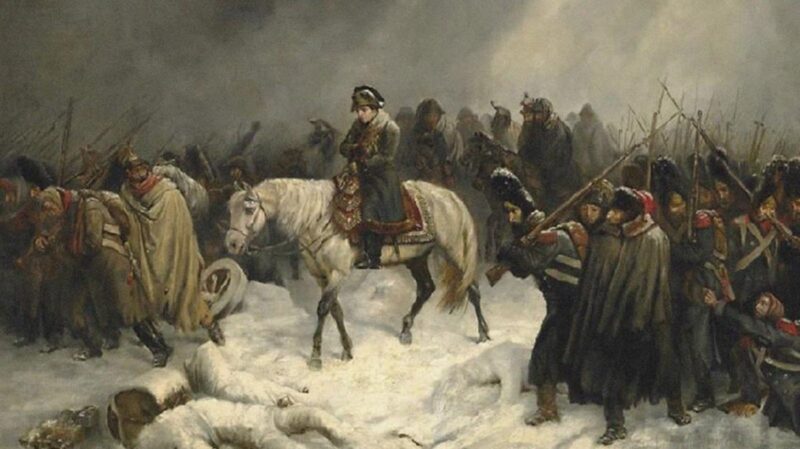An artist’s representation of Napoleon’s forces trudging through snow during the ruler’s ill-fated military campaign of 1812.
Getty Images
Historians have long known that as hundreds of thousands of Napoleon Bonaparte’s troops retreated from Russia in the winter of 1812, many died from infectious diseases such as typhus that were exacerbated by extreme cold and grinding exhaustion. DNA extracted from the teeth of a small number of those ill-fated soldiers is now pointing to additional illnesses that helped bring the army to its knees.
Scientists in France detected two previously unsuspected pathogens in the sequenced DNA — one responsible for paratyphoid fever, a relative of typhoid fever spread through tainted food and water, and another for relapsing fever, a disease transmitted by lice and and characterized by bouts of fever followed by periods of remission. The conditions correlate with symptoms described in historical accounts, but a new study, published in the journal Current Biology, provides the first genetic evidence of those two particular agents as contributors, putting names to conditions that symptom-based accounts alone can’t confirm.
The French emperor ordered between 500,000 and 600,000 troops to invade Russia in June 1812 for a mix of political, economic and strategic reasons, but the famous campaign didn’t go as planned. After reaching Moscow without fully defeating Russian forces, Napoleon’s troops found themselves stranded in a ruined, empty city void of supplies. In October, they began a long retreat, aiming to reach Poland and set up camps for winter. Instead, 300,000 of them died — most from illness and abject conditions rather than Russian fire, according to most accounts.
Imperial Guard button discovered during the dig of the mass grave in Vilnius, Lithuania, containing soldiers’ remains
©Michel Signoli UMR 6578 – CNRS, Aix-Marseille Université, EFS
Past research has already identified pathogens for typhus and trench fever that befell the retreating soldiers. The new study expands the list of ailments. “The retreat’s health crisis was multifactorial — several infections co-circulated alongside cold and hunger,” Nicolás Rascovan, head of the microbial paleogenomics unit at the Institut Pasteur and a co-author of the study, said in an interview.
“The retreat looks less like ‘one disease plus winter’ and more like overlapping infectious diseases and very poor sanitary states in extreme conditions,” added Rascovan, who studies the DNA of ancient pathogens.
The DNA sequenced by the team from Institut Pasteur and Aix Marseille University’s Laboratory of Biocultural Anthropology came from the teeth of 13 soldiers exhumed from a mass grave of 3,000 corpses discovered during construction work in Vilnius, Lithuania, in 2001. Microbial DNA in bits of blood and tissue from the teeth of four skeletons tested positive for Salmonella enterica, which is responsible for paratyphoid fever and two for Borrelia recurrentis, which links to relapsing fever. One soldier’s remains carried both.
Pathogen DNA is typically fragmented in ancient human remains, Rascovan notes, and only present in very low quantities, making it hard to obtain whole genomes. This case was no different. The team had to develop an authentication workflow that included comparing DNA sequences from the 19th century remains to databases of modern microbes to pinpoint exactly which lineage caused the diseases.
Why A Mass Grave In Vilnius?
Vilnius was a key waypoint on the 1812 retreat route, and late that year, the city saw a mass arrival of ill soldiers.
“In winter, under crisis conditions and with urgent sanitation concerns, authorities resorted to rapid, collective burials,” Rascovan said. The mass grave “reflects emergency mortuary practice in a catastrophic moment, not a targeted killing site.”
The military campaign was, at its core, about the all-powerful Napoleon forcing Russia back into a large-scale embargo of Britain, its economic rival, and consolidating his dominance over Europe.
“The whole campaign was a logistical nightmare and a catastrophe waiting to happen,” British military historian and writer John Lee, who was not involved with the research, said in an interview. “Before it even began there were French logistical officers begging the emperor not to invade Russia. They looked at the distances involved and the resources required and thought it a bad idea.”
DNA extracted from the teeth of 13 soldiers from Napoleon’s army has yielded new information on what illnesses they suffered from.
EU/Claudio Centonze
Lee notes that even before the retreat, which took place between October 19 and December 14 of 1812, Napoleon’s army was already suffering massive losses both of horses and enfeebled troops. “Perhaps a third of the army was lost in the advance, never mind the retreat,” he said.
While the study findings illuminate the grim realities of that catastrophe, the study authors stress that the low number of samples analyzed — compared with the thousands of bodies found in the mass grave — makes it impossible to determine how much the newly discovered pathogens contributed to the troops’ high death rate.
In addition, the findings don’t fundamentally alter the broader understanding of why Napoleon’s campaign failed, according to Rafe Blaufarb, a Florida State University history professor who was not involved with the research.
“Until the invention of antibiotics in the 20th century, soldiers in most wars died of disease,” Blaufarb said in an interview. “That we now know what one of those diseases was in one of those wars is a nice addition, but it doesn’t change our historical understanding of the causes of the destruction of Napoleon’s army.”
Yet identifying specific pathogens does help animate the world of the early 19th century battle, illuminating specific disease transmission routes and living conditions during the early 19th century battle.
“That helps historians reconstruct camp life, supply failures and hygiene practices, and lets epidemiologists trace how pathogen lineages moved and persisted,” Rascovan said. “It also calibrates symptom-based accounts that can’t distinguish, for example, typhus from enteric fevers.”
Information such as this, he said, not only deepens our understanding of the soldiers’ suffering, but offers insights that can help scientists better understand and tackle infectious diseases today.
Archaeologists excavating the mass pit of soldiers’ remains discovered in 2001 during construction in Vilnius, Lithuania.
©Michel Signoli UMR 6578 – CNRS, Aix-Marseille Université, EFS









